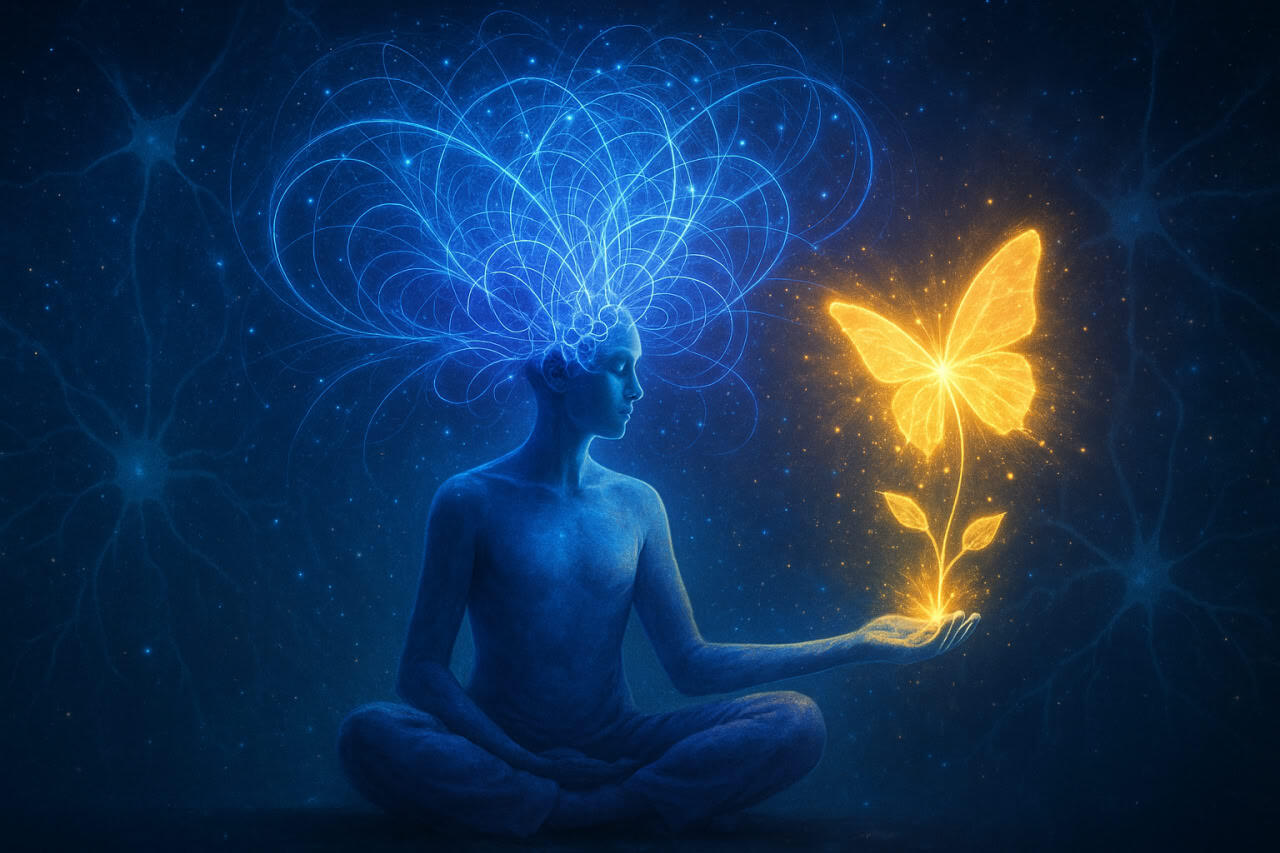Unlocking the Power of Intention: How Quantum Mechanics Reveals the True Nature of Consciousness and Reality

Have you ever wondered why some thoughts seem to shape your world while others fade into oblivion? In a universe governed by unseen forces, the simple act of intending something can spark profound change. This isn’t just wishful thinking—it’s rooted in the fascinating interplay between quantum mechanics and human consciousness, where potential becomes reality not through brute force, but through alignment and awareness. As we delve into this realm, we’ll explore how intention acts as a catalyst for transformation, challenging old paradigms and offering a path to higher living.
The Quantum Shift: Moving Beyond Newtonian Causality
For centuries, our understanding of the world was dominated by Isaac Newton’s laws of motion and causality—a predictable chain where one event directly causes another, like billiard balls colliding on a table. But the advent of quantum mechanics in the early 20th century shattered this mechanical view. Pioneered by scientists like Niels Bohr, Werner Heisenberg, and Erwin Schrödinger, quantum theory introduced a probabilistic universe where particles exist in states of potential until observed or measured.
At the heart of this is the concept of wave function collapse. In quantum terms, reality isn’t fixed; it’s a superposition of possibilities. When we “observe” or interact with these possibilities, one outcome emerges as actuality. This isn’t mere philosophy—experiments like the double-slit test demonstrate how particles behave as waves until measurement forces them into particle form. What does this mean for us? It suggests that consciousness plays an active role in shaping reality, a idea echoed in the works of physicists exploring the mind-matter connection.
Henry Stapp, a renowned mathematical physicist who collaborated with giants like Heisenberg and John Wheeler, has been instrumental in bridging quantum mechanics with consciousness. In his explorations, Stapp argues that mental processes aren’t passive byproducts of brain activity but active influencers in the quantum domain. He proposes that conscious choices exploit quantum effects, such as the Zeno effect, where repeated observation stabilizes a system. This ties directly to intention: our focused mental states can “select” from quantum possibilities, nudging potential into manifestation.
Consider the implications. In a Newtonian world, you’d force a seed to grow by applying pressure or chemicals—likely destroying it in the process. Quantum thinking flips this: provide the right conditions—warmth, light, water—and add intention. The seed, like a cocoon, unfolds naturally into a flower or butterfly. No coercion, just emergence. Stapp’s model aligns with this, suggesting that intention operates in the “linear domain” of intellect, edging closer to true consciousness.
This shift has ripple effects across fields. In psychology, it explains phenomena like the placebo effect, where belief in healing triggers real physiological changes. Studies from institutions like Harvard Medical School show patients improving from sham treatments, their intentions aligning with bodily responses at a subcellular level. Spiritually, ancient traditions like Buddhism and Hinduism have long emphasized mindfulness and intention (sankalpa in Sanskrit) as tools for reality-shaping, now finding echoes in modern physics.
But why does this matter today? In an era of rapid change—think AI advancements, climate crises, and personal burnout—understanding quantum intention empowers us to move from reactive survival to proactive creation. It’s not about controlling everything; it’s about harmonizing with the universe’s probabilistic flow.
Intention as the Catalyst: From Potential to Actuality
Intention isn’t just a fleeting thought; it’s a directed force that collapses quantum potentials into tangible outcomes. Unlike casual wishing, true intention involves clarity, emotion, and alignment. Stapp’s work in “Mindful Universe” elaborates on this, positing that mental intentions translate into bodily actions via quantum processes in the brain’s synapses. He draws on von Neumann’s foundations, where consciousness enters the equation to resolve quantum ambiguities.
Imagine planting a garden. You don’t command the seeds to sprout; you intend growth by preparing soil, watering consistently, and visualizing abundance. Under proper conditions, potential blooms. This mirrors quantum emergence: the “proper context” includes environmental factors and your conscious focus. As Stapp notes, our minds lack a traditional wave function but use projection operators to influence physical states.
This concept challenges materialist views that reduce everything to atoms and neurons. Instead, it supports a participatory universe, where we’re co-creators. Experts like Deepak Chopra, collaborating with Stapp, question whether mind-elements are needed to interpret quantum mechanics, suggesting undetermined choices evolve the physical world.
Real-world applications abound. In business, entrepreneurs like Oprah Winfrey credit intention for success—visualizing goals as already achieved aligns actions with opportunities. Scientific backing comes from neuroplasticity research: fMRI scans show how focused intention rewires brain pathways, enhancing resilience and creativity. A 2019 study in the Journal of Neuroscience found meditators exhibiting stronger gamma waves, linked to intention and manifestation.
Spiritually, intention fosters communal power. Group meditations, like those in Transcendental Meditation experiments, have correlated with reduced crime rates in cities—a “Maharishi Effect” hinting at collective quantum influence. If one person’s intention is potent, imagine a group’s: it amplifies the field, turning individual potentials into shared actualities.
Yet, pitfalls exist. Misaligned intentions—driven by fear or ego—can backfire, manifesting unwanted outcomes. The key? Purity and context. As ancient wisdom teaches, intention thrives in gratitude and detachment, allowing the universe to respond without force.
Expanding on this, consider quantum entanglement, where particles linked across distances mirror each other’s states instantly. Applied metaphorically, our intentions entangle with others’, creating synchronicities. Carl Jung’s synchronicity concept aligns here: meaningful coincidences arise from acausal connections, perhaps quantum in nature.
For personal growth, start small. Intend clarity before a meeting; notice how ideas flow. Over time, this builds momentum, shifting from doubt to trust in the process.
Brain Physiology: The Divide Between Animal Instinct and Higher Awareness
One of the most intriguing aspects of consciousness is its physiological underpinnings. Research reveals stark differences in brain function across awareness levels, often calibrated on scales like those developed by consciousness researchers. Below a critical threshold—say, around integrity level 200—processing leans toward left-brain dominance, home to analytical, survival-oriented thinking. This mirrors animal responses: threat detection, territoriality, binary friend-foe distinctions.
In this state, perception distorts. Agreements foster alliances; disagreements spark attacks. It’s evolutionarily adaptive for survival but limiting for growth. Neuroimaging studies, such as those from the Max Planck Institute, show heightened amygdala activity (fear center) in low-awareness states, overriding prefrontal cortex rationality.
Above this threshold, right-brain dominance emerges, fostering holistic, intuitive processing. Creativity, empathy, and contextual understanding flourish. This shift isn’t arbitrary; it’s tied to neurochemical balances, like increased serotonin and dopamine in higher states.
Why the divide? Evolutionary biology suggests early humans needed left-brain vigilance for threats. Modern spirituality posits it’s a consciousness evolution: transcending ego-driven reactivity toward unity.
Implications for society are profound. In politics, low-integrity discourse fuels polarization—viewing opponents as enemies rather than limited perspectives. Higher awareness promotes dialogue, seeing disagreements as growth opportunities.
Personal health benefits too. Chronic stress from left-brain overdrive leads to ailments like hypertension; mindfulness practices shift to right-brain balance, reducing cortisol. A 2022 meta-analysis in Psychological Bulletin linked higher consciousness to longevity, attributing it to better emotional regulation.
Understanding this physiology demystifies human behavior. That rude colleague? Likely operating from limitation, not malice. This leads seamlessly to forgiveness.
Forgiveness: Transcending Limitation Through Compassion
Forgiveness often feels elusive, burdened by hurt and resentment. Yet, viewing it through brain physiology and quantum lenses transforms it into an act of liberation. At core, errors stem from limitation—physiological constraints below higher consciousness levels. People in survival mode can’t help their reactivity; it’s wired in.
Historical figures like Jesus Christ exemplified this: “Forgive them, for they know not what they do.” It’s not excusing harm but recognizing incapacity. In quantum terms, low-awareness individuals are entangled in distorted potentials, unable to collapse higher outcomes.
Stapp’s model supports this: free will operates via quantum choices, but limited brains restrict options. Forgiving acknowledges this, freeing energy for your growth.
Practically, forgiveness involves reframing. Journal triggers, meditate on the offender’s limitations, intend release. Studies from Stanford’s Forgiveness Project show health benefits: lower blood pressure, improved immunity.
In relationships, it breaks cycles. Instead of attacking “evil,” avoid engagement—as advised in spiritual teachings. Discard toxic emails; set boundaries without war.
Culturally, forgiveness heals divides. Post-apartheid South Africa’s Truth and Reconciliation Commission embodied this, fostering national unity through understanding over vengeance.
Ultimately, forgiveness elevates your consciousness, aligning with quantum flow for positive manifestations.
Practical Applications: Integrating Intention into Daily Life
Bringing these concepts home requires action. Start with morning intentions: visualize your day with positivity. Use affirmations rooted in quantum truth—”I align with abundant possibilities.”
In challenges, apply brain awareness. Feeling reactive? Pause, breathe, shift to right-brain empathy.
For manifestation, create “quantum rituals.” Meditate on goals, feel them as real—emotions amplify quantum fields. Track synchronicities; they’re signs of alignment.
Communally, join intention groups. Online forums or local circles amplify effects, as seen in global peace meditations reducing violence metrics.
Professionally, leaders like Google’s mindfulness programs harness this for innovation. Employees intending collaboration foster creative breakthroughs.
Ethically, wield intention responsibly. Avoid manipulation; focus on mutual benefit.
Over time, this integration raises collective consciousness, tipping society toward harmony.
The Broader Implications: Consciousness in a Quantum World
As we advance, quantum consciousness reshapes fields. In medicine, intention-based therapies like biofield healing gain traction, with NIH-funded studies showing efficacy.
Environmentally, collective intention could aid sustainability—envisioning a healed planet aligns actions globally.
Philosophically, it revives idealism: mind precedes matter. Critics argue it’s pseudoscience, but evidence mounts—quantum biology in photosynthesis, bird navigation.
Future tech, like quantum computing, may simulate consciousness, blurring human-machine lines. Ethically, intention guides responsible use.
In education, teaching quantum principles empowers youth to intend futures beyond limitations.
Conclusion: Embracing the Emergent Self
In weaving quantum mechanics with intention and consciousness, we uncover a universe of boundless potential. No longer bound by causality’s chains, we emerge like butterflies from cocoons—transformed by alignment, not force.
The takeaway? Cultivate intention daily. Understand physiological limits in yourself and others; forgive freely. In doing so, you not only elevate your life but contribute to a more conscious world.
As Stapp reminds us, our minds participate in reality’s unfoldment. What will you intend next?



